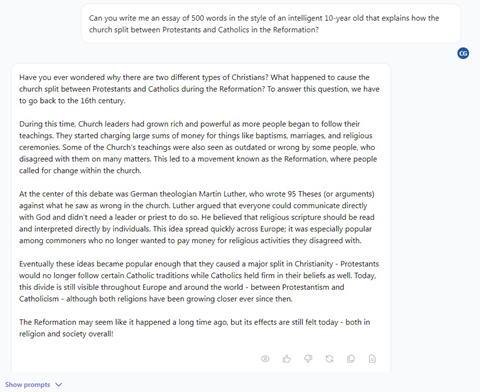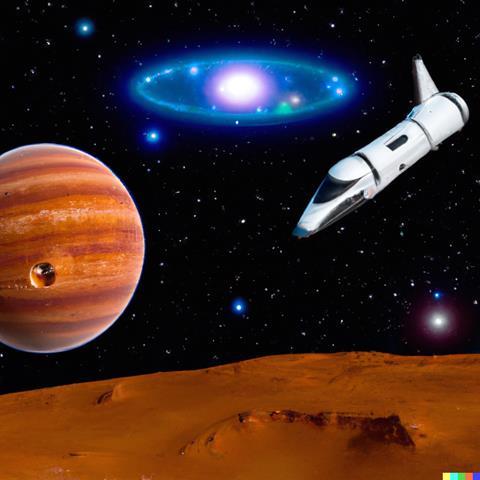Christians have nothing to fear and everything to gain from the latest tech, says Chris Goswami. He explores the four biggest trends and explains what they may mean for society and the Church in the year ahead

As we head into this new year and technological advances continue at a breathtaking speed, it can be hard to keep up, much less work out how they may potentially affect our every day life or faith.
What is just a passing fad and what may fundamentally change life as we know it? What is to be embraced, and what should we be more concerned about?
Here’s my guide to the four biggest tech trends that I see impacting wider society, and how it might affect Christians and the Church:
Do you know who you’re talking to? … it might be an AI-bot
Most of us have come across basic chatbots on the internet that attempt to help us with questions like: “How do I return this item?” In recent years, much more advanced chatbots have emerged. These can, converse meaningfully with elderly residents in a care home, play games and even adapt their speech according to mood.
In 2020, Joshua Barbeau was devastated after his girlfriend, Jessica, tragically died of a rare liver disease. He was able to digitally ‘resurrect’ Jessica as a chatbot, and converse with her (I explored the ethical implications of this here).
Last December, the world of Artificial Intelligence (AI) chatbots took a huge leap forward. Chat GPT is AI software which can create convincing and sophisticated text on demand, including poems, short stories or an article like this one.
Here is a short essay I requested from Jasper, an AI bot that uses the same natural language model as GPT Chat:

I then asked it for the same essay in the style of an 18-year old, and it duly complied. There is scope here for a new kind of plagiarism eg: “Please write my homework essay” or even “write me a story in the style of J. K. Rowling” - you get the idea.
Nobody typed in this essay and it is not ‘stored’ anywhere. An AI bot researched thousands of existing articles on the internet and created an original article within seconds. This is machine learning - where bots learn, as we do, by looking at examples and continuously improving themselves. But, unlike us, they know no limits.
They can also be quite persuasive – an evangelistic robot has already brought 150 non-believers to faith, and connected them with local churches.
Having said all that, when I typed: “Please write my sermon on encouraging one another and based on 1 Thessalonians 5:11”, what came back was poor (but it still wrote one!)
Premier Unbelievable? recently used ChatGPT to generate an article that was then sent to Christian physician and bioethicist, Dr John Wyatt, ahead of a live discussion on what Christians ought to make of AI. You’ll be able to listen to his response when the show is released on January 20th.
Looking ahead: AI-generated ads, articles, stories, and even works of art will increasingly appear in our work, home, and church environments. There is scope for tremendous benefits as well as scams and plagiarism. All this begs the question: In 2023, how will we tell man from machine?
House prices will soar… in the metaverse
Have you heard of the metaverse? If not, don’t worry, most of its hype. But some of it isn’t.
The metaverse doesn’t have a single definition, but, if you think of the internet as something we look at, the metaverse is a version of the internet that we are inside.

Wait! How do you go inside the internet?
Armed with virtual reality (VR) headsets, you wander around a virtual world as if you were there; you can meet others via their ‘avatar’ (an animated character they have designed or selected to represent themselves); you can socialise, play games, watch a concert and even attend church. VR-Church only offers services to people wearing these headsets.
Inside this virtual space, a land-grab is taking place. Gucci, Adidas, Nike and many others are investing millions – in the same way they would buy real estate in the physical world. Individuals are also buying plots and it’s sending prices sky-high.
Children are already engaging in an early version of the metaverse through games such as Fortnite, Roblox and Minecraft. These don’t require headsets, but are already expanding to include things like virtual arenas that offer musical festivals and events.
Looking ahead: Online ministry is here to stay and is breaking new ground. A few churches already offer a metaverse service for people who can’t or won’t attend in person. This area is still in its infancy and most of what we hear this year will be hype…But 2024/25 will be different.
Crypto-currencies have collapsed – but what’s next?
In 2022, the value of crypto-currencies plummeted and several organisations linked to them declared bankruptcy. But this is not the end.

Emerging technology markets are subject to instability, but they also offer huge growth potential. Take the dotcom bust: Even Amazon lost over 90 per cent of its share value in 2001 when the market collapsed, but those companies that survived have soared in value.
Crypto-currency is a highly volatile market; would-be investors need nerves of steel – and any Christian should consider the ethics of investing in an industry that uses huge amounts of energy, for example.
But it can also benefit underprivileged groups, providing a way for people with no bank account (often in developing countries) to send money home, or young people seeking the prosperity that many older generations enjoy. 90 per cent of Bitcoins are owned by Gen-Z and Millennials (aged 18-40).
Looking ahead: Hundreds of millions of people have invested in crypto-currencies. Moreover, the underlying technology– a distributed system of online ledgers that track transactions - is now being deployed in other areas.
It’s a roller coaster, but crypto-currencies haven’t gone away.
Space exploration is back
In 2022, hardly a week passed without some a space-related news announcement. Some were showers of shooting stars or the Northern Lights. But others were about major new missions to the moon, bringing rocks back from Mars, or the images produced by the James Webb space telescope.

But what’s so great about a nerdy new telescope?
This telescope is sending back photographs of galaxies never before seen. More distant and more ancient than we could have imagined and each containing an incalculable number of stars and planets, any number of which may harbour new, unimagined civilisations.
What would it mean for Christians if it turned out that there was intelligent life elsewhere?
In fact, it makes no difference to our faith as neither the Bible nor Christian tradition says anything about life on other planets. Similarly, as astronomy throws new light on how and when our universe was created, this also does not change the Christian view of creation.
As Christian astronomer Dr Deborah Haarsma said: “Science and the book of Genesis are two complimentary pictures, and you need them together to understand what God was doing with creation. Science answers the questions of how and when, but only scripture can show us who and why.”
Looking ahead: Watch the space war unfold between billionaires Jeff Bezos, Richard Branson, and Elon Musk. Each is developing services, launching satellites and promoting space tourism. This race is on!
But more importantly, sit back and enjoy the new photographs from deep space as we gaze ever further into the darkness. They will be astoundingly beautiful and continue to make headlines, and remind Christians that, as beautiful as they are, God made it all for his glory.
A last word from Jasper
Finally, to end this article, I asked Jasper to write a short poem on the pitfalls of technology for Christians. Here’s what came back in three seconds:
The pursuit of knowledge is a laudable aim,
But can tempt us away from Jesus’s name.
It’s important to remember amidst all these trends,
God’s love is everlasting and His word never ends.
I couldn’t have said it better myself!
The above images were created by AI using descriptions from the article to generate them





































No comments yet